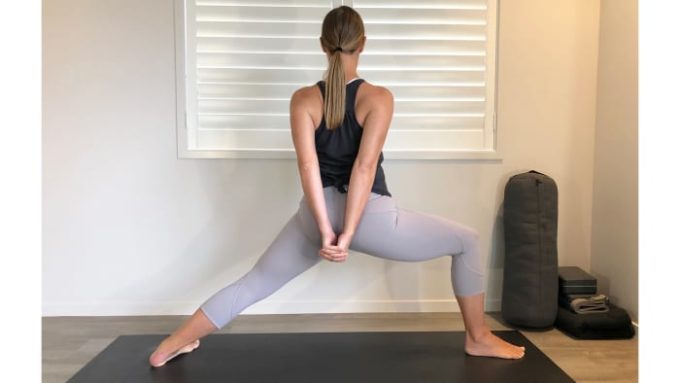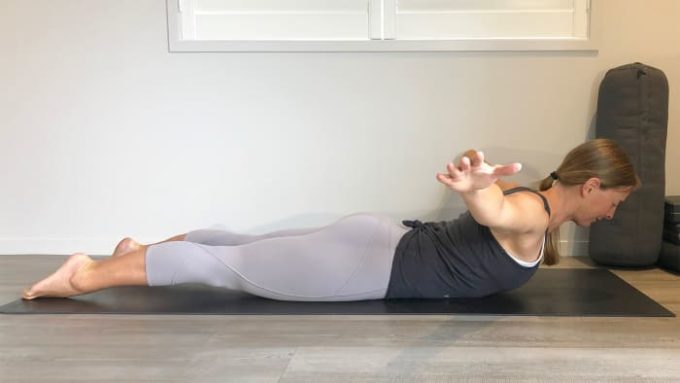• Awaken your posterior shoulder muscles by utilizing arm positions that require active shoulder retraction or external rotation, such locust pose with T arm or cactus arm variations.
Chaturanga Dandasana
• Develop a more central weight-bearing position for the head of your shoulder in Chaturanga Dandasana by broadening your collarbones and turning your sternum forward. This position will be much easier to maintain if you stay higher in the pose, keeping your shoulders above elbow height. You might also consider skipping Chaturanga at times to build more variety into your yoga practice.
Postural Pattern No. 2: Lower Cross Syndrome & Hamstring Tendonitis
Another common yoga injury is pain in the proximal tendon of the hamstrings, where they attach to the sit bones at the base of the pelvis. This appears as a nagging, pulling pain just below the sit bones that often feels worse after stretching or sitting for long periods.
The Anatomy:
Most of us spend hours of each day sitting, and our soft tissues adjust to this habit. One such adjustment is the common muscular pattern called lower cross syndrome, where the hip flexors on the front of the pelvis and thighs (including the iliopsoas and rectus femoris) tend to become tight and the hip extensors on the back of the pelvis and thighs (including gluteus maximus and the hamstrings) tend to weaken, tilting the pelvis forward.
In yoga we often exacerbate this pattern by stretching our hamstrings far more often than we strengthen them. Over-stretching these weak muscles has the potential to irritate their tendinous attachment to the sit bones. The position of these tendons underneath the base of the pelvis also means that they are compressed every time we sit, potentially reducing their blood flow and making them slower to heal.
Every time we flex our hips, especially with straight legs, we lengthen the hamstrings. This makes the list of yoga poses to be aware a long one, including standing forward bends, seated forward bends, Extended Hand to Big Toe Pose (Utthita Hasta Padangusthasana), Pyramid Pose (Parsvottanasana), Splits (Hanumanasana), Standing Splits (Urdhva Prasarita Eka Padasana), Head to Knee Pose (Janu Sirsasana), Supine Hand to Big Toe Pose (Supta Padangusthasana), Downward Facing Dog, and others.
See also Get to Know Your Hamstrings: Why Both Strength & Length Are Essential
How to reduce your hamstring injury risk:
Focus any hamstring stretches on the belly of the muscle. If you feel a stretch tugging on your sit bones when you stretch, move away from that sensation immediately by bending your knees or backing out of your full range of motion.
Bridge Pose (Setu Bandha Sarvangasana)
• Work on strengthening your hamstrings as often as you stretch them. Incorporate Locust Pose (Salabhasana) and Bridge Pose (Setu Bandha Sarvangasana) variations into your practice more often. You could also try stepping your feet a few inches further away from your torso in bridge pose to highlight hamstring contraction instead of glute contraction. Finally, keeping your hips square to the mat when you lift a leg behind you in Downward Facing Dog and the kneeling Balance Bird Dog Pose will highlight hamstring (and gluteus maximus) contraction.
Balance Bird Dog Pose
Postural Pattern No. 3: Posterior Pelvic Tilt & Lumbar Disc Injuries
If you’ve ever had a lumbar disc rupture or protrusion—or been one of the 80% of adults that have experienced any kind of low back pain—you’ll remember how vividly aware you became of the movements and positions that put pressure on your spine, and how many of those appeared in the average class.
The Anatomy:
Our column of vertebra is connected by two moveable facet joints at the back of the spine and are sandwiched together by intervertebral discs at the front of the spine. When we lean back or take the spine into extension (a backbend), we load the facet joints; when we lean forward or flex the spine (into a forward curl) we load to the discs. If we fold more deeply forward, add weight by reaching with our arms, add sheering force by twisting the spine, or alter our pelvic position by sitting, we significantly increase the load on our discs.
Not all of us experience Lower Cross Syndrome; for some, slouching in our seat creates the opposite postural pattern, sending our pelvis into posterior tilt. The altered pelvic position has flow-on effects, one of which is to flatten the natural curve in our lumbar spine, bringing it out of extension into slight flexion. This means that in what we perceive as our neutral posture we are already adding extra load on our intervertebral discs, before we even start to fold forward, add weight, or alter pelvic position.
In healthy discs, adding load isn’t necessarily a bad thing, but if our discs are damaged or degenerating, the extra force we exert in a yoga practice could be the last straw that leads to disc injury, causing the jelly like protein filling of our disc to leak out, potentially irritating neighboring nerves as well as reducing spine function in that area.
Any poses or movements that load the spinal discs are worth paying extra attention to. This includes seated forward folds like Paschimottanasana and Head to Knee Pose (Janu Sirsasana), Seated Twist (Ardha Matsyendrasana), as well as yoga transitions to and from standing like those in sun salutations between Mountain Pose (Tadasana) and Standing Forward Bend (Uttanasana), and between a Low Lunge and Warrior I (Virabhadrasana I).
How to reduce your disc injury risk:
The overall theme of reducing risk injury is to use your yoga practice to develop keener awareness of your posture. Once you know what a truly neutral lumbar spine and pelvis feel like, you can make a deliberate decision as to whether to add load to the discs by flexing the spine, rather than allowing your posture to make the decision for you.
Warrior III (Virabhadrasana III)
• Using mirrors, photos, help from a friend, or the tactile feedback of the floor, wall, or a dowel stick behind your spine, practice creating neutral lumbar spine and pelvis in various orientations to gravity. Start supine (as in Savasana), progress to standing upright (Tadasana), then explore other standing poses like Extended Side Angle (Utthita Parsvakonasana) or Warrior III (Virabhadrasana III).
Paschimottanasana Prep
• Pay particular attention to what is required to create a neutral sp















